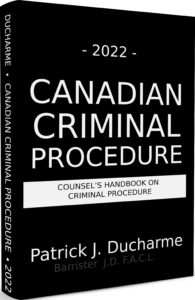 |
| Patrick J Ducharme |
In R. v. St-Cloud the accused was charged with aggravated assault. The incident giving rise to the charge was captured on a video recording system. The video demonstrated that the accused and two others assaulted a bus driver. In addition, there was eyewitness testimony. It was inarguable at the time of the bail hearing that the Crown’s case was strong since the incident was videotaped and the videotape was augmented by eyewitness testimony.
The accused was clearly an active participant in a serious case of assault with a bus driver who was obviously overwhelmed by three assailants. This case presented the Supreme Court of Canada with an opportunity to comment on the progeny of R. v. Hall.
The court in R. v. St-Cloud3 decided that when determining whether the detention of the accused is necessary to maintain confidence in the administration of Justice pursuant to subsection 515 (10) (c) of the Code the presiding Justice must first consider four circumstances that are expressly referred to in this subsection:
1. the apparent strength of the prosecution’s case.
2. the objective gravity of the offence in comparison with other offences.
3. the circumstances surrounding the commission of the offence, including whether a firearm was used and including whether the offence is one of violence, particularly heinous or hateful, or that allegedly involves domestic violence, a criminal gang or a terrorist organization or a particularly vulnerable person, and, aggravating and mitigating factors that the courts would normally consider for sentencing purposes; and finally,
4. whether the accused is liable to a potentially lengthy term of imprisonment. (However, it is not desirable to establish a strict rule regarding the number of years that constitutes a lengthy term of imprisonment).
The circumstances listed in subsection 515 (10) (c) should be guided by how these considerations may be viewed by the public, that is, by a reasonable person who is properly informed about the philosophy of the legislative provisions including subsection 11(e) of the Charter.
4.a. the evidence must be credible in the sense that it is reasonably capable of belief, taking into consideration the relaxed rules of evidence at a bail hearing and particularly the evidence that is permitted pursuant to subsection 518 (1) of the Code; and, the last criterion,
4.b. somewhat modified from the principles outlined in Palmer, that it could have affected the balancing process exercised by the Justice conducting the original judicial interim release hearing.

The above is the an excerpt of Patrick J Ducharme's book, Canadian Criminal Procedure, available at Amazon or in bulk through MedicaLegal Publishing along with Criminal Trial Strategies.
Subscribe to Patrick Ducharme's Youtube Channel
